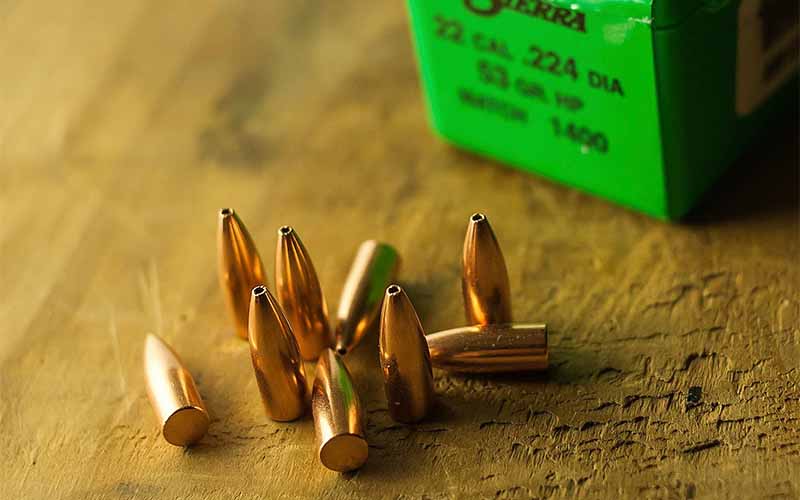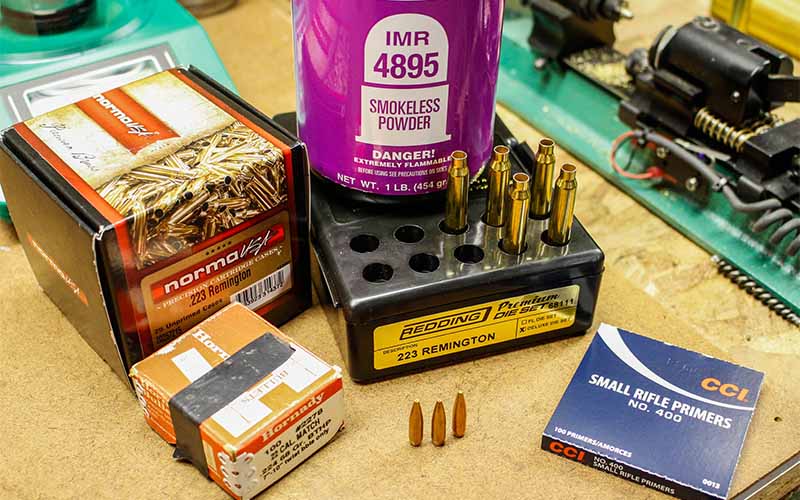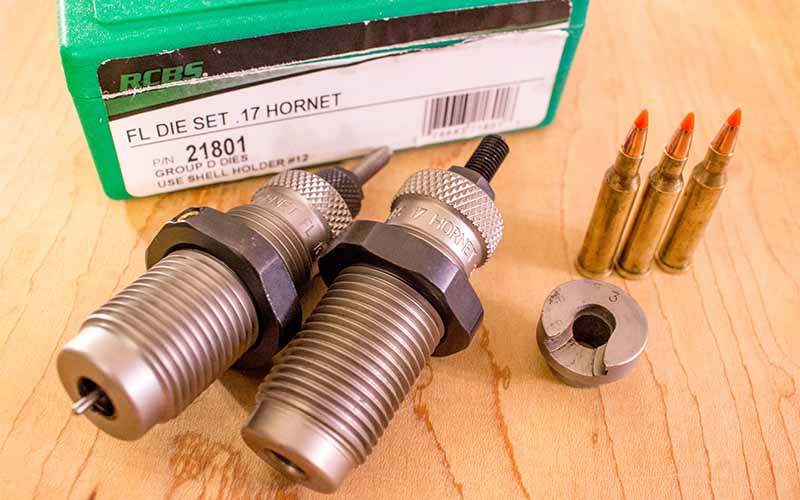
Some tips on how to find big success when reloading cartridges with small projectiles.
The processes involved in reloading a centerfire rifle cartridge don’t vary drastically when comparing case and bore size, but there definitely seem to be some idiosyncrasies involved with the smaller cartridges. Perhaps it’s the accuracy expectations of a small-bore cartridge, or the game species that are hunted with those smaller cartridges, which have us looking for one-hole groups … or at least tiny little clover leaf groups.
In my experience, the moderate velocity big-bore cartridges can often be more forgiving than the speedier small-bores, or perhaps I should say I’ve often been able to reach the goal line faster with a big-bore cartridge. Along the line, I’ve had some trials and tribulations with the smaller cartridges, and depending on the application for your reloading needs, there are some ideas and techniques that might save you some time.
Learning The Hard Way
I started the small-bore journey by loading for the .223 Remington and .22-250 Remington, in a couple of rifles that gave me fits. My dad had purchased a Ruger Mini-14, which, no matter what we fed it, was a 2-inch rifle. We tried multiple factory loads and then began to handload for the clunker. I thought I didn’t know what I was doing, until we tried the handloads in a buddy’s bolt rifle and saw ½-MOA groups; the strict regimen was working, but the rifle didn’t read the script.

My next experience was with a Ruger Model 77 MKII in .22-250, with a sporter-weight barrel, that I purchased for hunting coyotes, fox and woodchucks. No matter what I tried, I couldn’t get the gun below an inch, often with a flier. Some shooting buddies who had heavy-barreled Remington 700s with finely tuned triggers were routinely printing ¼-MOA groups, and they were kind enough to share their load data.
No dice in my rifle.
What it took was a change of projectile and a new trigger—those mid-1990s Rugers had a non-adjustable trigger that broke at about 6 pounds, and my rifle has a crown that much prefers the flat-base Sierra MatchKing bullet. A Timney trigger and a 53-grain MatchKing, plus an appropriate charge of Hodgdon’s H380, saw the rifle finally print ½-MOA groups.
Both those rifles had issues, but they taught me some lessons that came in handy later in life. Because I couldn’t get them to print, I started to examine each and every detail of the equation, from the components and their consistencies to the fine-tuning of the cases and the methods of assembly. Small-bore cartridges—especially those which generate higher velocities—can magnify any errors or deviations, and the target board can reflect that. So, I learned some tricks and tips to obtain the best results with these little guys.

Small Projectiles, Small Details
Velocity comes at the price of pressure, and consistent pressures can equate to consistent velocities, and correlative precision. If your cases are of differing volumes, the same powder charge will generate a slightly different pressure level, so trying to keep things as uniform as possible will best keep velocities even.
If you’re after the finest precision, weighing your cases after trimming and resizing can indicate which cases have slightly thicker walls; the outside dimensions being the same, a case with thicker walls will be heavier and have a smaller combustion chamber. For best precision and consistency, sort your cases into lots, using the most uniform for the best match-grade accuracy.
Primer choice can make a big difference in small-bore loads, and I’ve long felt this class of cartridge is more susceptible to differences in primer heat. If you like the .220 Swift or .22-250 Remington, any large rifle primer will get things to go bang, but I like a match-grade primer like the Federal Gold Medal Match GM210M. That primer has given such excellent performance across the board that I generally reach for that first to save me time and effort.
The same can be said for the small rifle primers, where the Federal GM205M Gold Medal Match offers the same consistency for the smaller cases, though I’ve had good results with the CCI 400 or the CCI BR-4 Bench Rest primers. In the end, whichever primer gives the lowest velocity spread is usually the one that gets the nod from me. The point: Simply switching a brand or type of primer has made all the difference in some rifles.
Powder choice is also highly important, as it has made an absolute world of difference in some cartridges. Where I can feed my .375 H&H Magnum just about any powder, from IMR 3031 to H4350, some of these little cases are very particular about the powders they like. My .22-250 shows a marked preference for Hodgdon’s H380, and the 17 Hornet likes Hodgdon’s CFE BLK and Accurate LT-30.

On the other side of the spectrum, the .223 Remington is one of those cases that seems to be more forgiving. I’ve used H335 and BL-C(2) with great effect, and a couple of Shooters World powders—the AR Plus and Tactical Rifle—have been excellent performers, with the latter giving very tight and consistent groups.
Case preparation can also help tighten up groups; I like to full-length resize in most instances, and I also feel that a uniform flash hole can make a real difference. When it comes to the highly frangible varmint bullets, or those match bullets that stake their reputations on highly concentric jackets, a poor chamfer on a case mouth can scratch and sometimes deform a bullet to the point where the ballistic coefficient will change, and long-range accuracy will degrade.
A good VLD chamfer tool, like Redding’s piloted P15 chamfer tool—which uses the cartridge’s flash hole to keep the chamfer as concentric as possible—will allow for easier seating of your projectile and minimize any damage to the jackets.
Lastly, I feel small-bore cartridges warrant the weighing of every powder charge, especially when it comes to the smaller cases like the .17 Hornet and .22 Hornet. With minimal case capacity, an overcharge of 0.2 or 0.3 grain can push pressures into the red, so err on the side of caution and weigh each charge—it’ll also give the best accuracy and consistency in your handloads.
Editor's Note: This article originally appeared in the January 2024 issue of Gun Digest the Magazine.
More On Reloading:
- Tips For Reloading the .30-06 Springfield
- Loving Your Luger: Reloading the 9mm Luger
- Handloading: Tips For Reloading The 7mm Rem Mag
- How To: Tips For Reloading the .223 Remington
- Reloading Bench: The Inside On Reloading For The .30-30 Winchester

Next Step: Get your FREE Printable Target Pack
Enhance your shooting precision with our 62 MOA Targets, perfect for rifles and handguns. Crafted in collaboration with Storm Tactical for accuracy and versatility.
Subscribe to the Gun Digest email newsletter and get your downloadable target pack sent straight to your inbox. Stay updated with the latest firearms info in the industry.

![Best Concealed Carry Guns In 2025 [Field Tested] Wilson Combat EDC X9S 1](https://gundigest.com/wp-content/uploads/Wilson-Combat-EDC-X9S-1-324x160.jpg)


![Best 9mm Carbine: Affordable PCCs [Tested] Ruger Carbine Shooting](https://gundigest.com/wp-content/uploads/Ruger-Carbine-Shooting-100x70.jpg)
![Best AR-15: Top Options Available Today [Field Tested] Harrington and Richardson PSA XM177E2 feature](https://gundigest.com/wp-content/uploads/Harrington-and-Richardson-PSA-XM177E2-feature-100x70.jpg)
